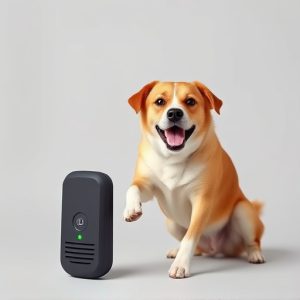Ultrasonic Bark Control Devices: Protecting Yourself from Aggressive Dogs
Aggressive dog behavior requires a strategic approach for personal safety. Ultrasonic bark control d…….
Aggressive dog behavior requires a strategic approach for personal safety. Ultrasonic bark control devices offer a humane alternative to traditional collars, using inaudible sound waves to disrupt barking without harm. When comparing these devices, consider factors like sensitivity settings, motion sensors, and effectiveness based on dog size and bark intensity. A thorough comparison ensures the chosen device aligns with individual needs and preferences. Combining this with positive reinforcement training is key for long-term success in managing aggressive canines.
Personal safety around aggressive dogs is a pressing concern, with many individuals seeking effective strategies. This article guides you through understanding dog aggression, from causes to signals, and offers a comprehensive overview of traditional vs. ultrasonic bark control devices. We delve into the mechanisms and efficacy of ultrasonic technology, highlighting its advantages in a detailed comparison. Key factors for choosing the right device are explored, along with training methods, ensuring long-term effectiveness.
- Understanding Aggressive Dog Behavior: Causes and Signals
- Traditional vs. Ultrasonic Bark Control Devices: A Comparison
- How Ultrasonic Bark Controls Work: Mechanisms and Efficacy
- Choosing the Right Device: Factors to Consider for Personal Safety
- Training and Combining Methods for Long-Term Effectiveness
Understanding Aggressive Dog Behavior: Causes and Signals
Aggressive dog behavior can be a complex issue, often stemming from various factors such as fear, territoriality, or past traumatic experiences. Understanding these underlying causes is crucial when it comes to personal protection. Dogs communicate their aggression through distinct signals, including vocalizations like barking and growling, body language changes like fur raising, and facial expressions. An ultrasonic bark control device can be a useful tool in this context, as it emits high-frequency sound waves that are often effective in deterring aggressive dogs without causing them harm.
When considering an ultrasonic bark control device, it’s essential to explore different models and their features. A comprehensive comparison of these devices can help you select the most suitable one for your needs. Some advanced devices even offer adjustable sensitivity levels, ensuring they respond only to specific barking patterns, minimizing false triggers and potential distress to innocent bystanders or pets with different behavior patterns.
Traditional vs. Ultrasonic Bark Control Devices: A Comparison
When it comes to protecting yourself from aggressive dogs, one effective tool that has gained popularity is the ultrasonic bark control device. These devices offer an innovative approach to deterring unwanted dog behavior compared to traditional methods. While both have their merits, understanding the differences can help pet owners make informed choices based on specific needs.
Traditional bark collars typically use static shocks or vibration to correct barking, while ultrasonic devices emit a high-frequency sound that is inaudible to humans but disrupts a dog’s communication and focus. The ultrasonic bark control device stands out for its non-invasive nature and ability to target specific behaviors without causing physical harm. This makes it an attractive option for pet owners seeking humane alternatives. However, traditional methods may be more effective for severe or consistent barking issues, as they directly stimulate the dog’s sense of touch or hearing. In terms of usability, ultrasonic devices are generally easier to operate and adjust, making them a convenient choice for everyday use.
How Ultrasonic Bark Controls Work: Mechanisms and Efficacy
Ultrasonic bark control devices operate by emitting high-frequency sound waves that are inaudible to humans but irritating to dogs. These devices use a mechanism that detects a dog’s bark and responds by emitting the ultrasonic signal, which serves as a deterrent. The sound is typically within the 25-64 kHz range, far above human hearing but within the sensitive frequency range of dogs.
When comparing different ultrasonic bark control devices, several factors come into play. Some models offer adjustable sensitivity levels to adapt to various environments and dog breeds. Others include motion sensors for more targeted activation, ensuring that the device doesn’t activate unnecessarily due to environmental noise or other animals. The efficacy of these devices varies; while they can effectively deter many dogs, particularly smaller breeds, larger dogs with deeper barks might not be as responsive. A thorough Ultrasonic Bark Control Device Comparison reveals a diverse range of options, each with unique features designed to cater to different needs and preferences for personal protection against aggressive dogs.
Choosing the Right Device: Factors to Consider for Personal Safety
When considering personal protection from aggressive dogs, choosing the right device is paramount. An Ultrasonic Bark Control Device can be an effective option for deterring dogs without causing harm. However, not all devices are created equal, and several factors should guide your decision. One key consideration is the range of the device; some models offer a wider range, making them suitable for larger areas like backyards or parks where multiple dogs might be present. Additionally, the frequency and intensity of the ultrasonic sound should be evaluated; higher frequencies are generally less irritating to humans but effective in stopping dogs.
Another critical aspect is the device’s reliability and ease of use. Read reviews comparing different Ultrasonic Bark Control Devices to understand their consistency and longevity. Some models may have advanced features like adjustable sensitivity settings, allowing you to customize the response based on different dog behaviors or environments. Ensure the device is portable and easy to activate, so you can quickly respond to unexpected encounters with aggressive dogs.
Training and Combining Methods for Long-Term Effectiveness
For long-term effectiveness in personal protection from aggressive dogs, combining training methods with technological aids like ultrasonic bark control devices is key. Training should focus on positive reinforcement to teach your dog good behavior and reduce aggression at its root. This involves consistent commands, rewards for desired actions, and patience during the learning process.
When paired with an ultrasonic bark control device, these training methods offer a multi-pronged approach. The device emits a high-frequency sound that is unpleasant to dogs when they bark excessively, reinforcing the lessons from your training sessions. It’s important to note that such devices should be used as a supplement to training, not a replacement. A comprehensive comparison of ultrasonic bark control devices can help you select one that best suits your needs and your dog’s temperament, ensuring their long-term effectiveness alongside consistent training.
When it comes to personal protection from aggressive dogs, an informed approach is key. By understanding the root causes of dog aggression and comparing various bark control devices like ultrasonic bark control devices, individuals can make educated decisions for their safety. While traditional methods have long been used, ultrasonic devices offer a innovative and effective solution. Consider factors like device mechanism, efficacy, and individual needs to choose the right tool. Combining this with training can lead to long-term effectiveness in managing and preventing aggressive dog encounters.


